The AMD Radeon RX 5600 XT Review, Feat. Sapphire Pulse: A New Challenger For Mainstream Gaming
by Ryan Smith on January 21, 2020 9:01 AM ESTPower, Temperatures, & Noise
Last, but not least of course, is our look at power, temperatures, and noise levels. While a high performing card is good in its own right, an excellent card can deliver great performance while also keeping power consumption and the resulting noise levels in check.
| Radeon Video Card Voltages | |||||
| 5600 XT Max | 5700 Max | 5600 XT Idle | 5700 Idle | ||
| 0.977v | 1.025v | 0.775v | 0.775v | ||
Interestingly, even with the BIOS update and AMD’s voltage-frequency curve extension, the voltages being used by our Sapphire Radeon RX 5600 XT are quite tame. The card never goes higher than 0.977v, which is almost 0.05v lower than the Radeon RX 5700, itself already a good deal lower than the full-fat Navi 10-based Radeon RX 5700 XT. While third-tier cards like the RX 5600 XT are uncommon, when we do see them they are normally running higher voltage (leakier) parts, and this is what I was expecting for AMD’s new part.
No wonder AMD is talking up the power efficiency of the card; even with its restricted clockspeeds, not going above 1.0v helps to ensure that power efficiency doesn’t take a dive by paying a massive power penalty to access the last few MHz worth of headroom.
| Radeon Video Card Average Clockspeeds (Rounded to the Nearest 10MHz) |
||||
| Game | Sapphire 5600 XT (Perf) | 5600 XT | 5700 | |
| Max Boost Clock | 1760MHz | 1670MHz | 1750MHz | |
| Official Game Clock | 1615MHz | 1375MHz | 1625MHz | |
| Tomb Raider | 1700MHz | 1610MHz | 1680MHz | |
| F1 2019 | 1700MHz | 1610MHz | 1650MHz | |
| Assassin's Creed | 1700MHz | 1660MHz | 1700MHz | |
| Metro Exodus | 1700MHz | 1600MHz | 1640MHz | |
| Strange Brigade | 1740MHz | 1660MHz | 1660MHz | |
| Total War: TK | 1740MHz | 1660MHz | 1690MHz | |
| The Division 2 | 1700MHz | 1610MHz | 1630MHz | |
| Grand Theft Auto V | 1720MHz | 1640MHz | 1690MHz | |
| Forza Horizon 4 | 1730MHz | 1650MHz | 1700MHz | |
Shifting over to clockspeeds, things look very good for the RX 5600 XT. The card’s clockspeeds are remarkably consistent, and this comes down to the fact that the card is rarely ever entirely power-bound. Rather, the card is running out of room on the voltage-frequency curve, making it very easy to get close to its peak clockspeeds in the process. This goes hand-in-hand with the relatively low voltage, allowing the card to run rather efficiently and avoid heavier power throttling.
Unsurprisingly, the card is closer to its peak when running at AMD’s reference clockspeeds than it is the default factory overclocked mode. Still, the latter sees the card average clockspeeds higher than the RX 5700, underscoring how these factory overclocked cards are primed to hit high clockspeeds, and that it’s going to be the lack of memory bandwidth that ultimately keeps them chasing the RX 5700.

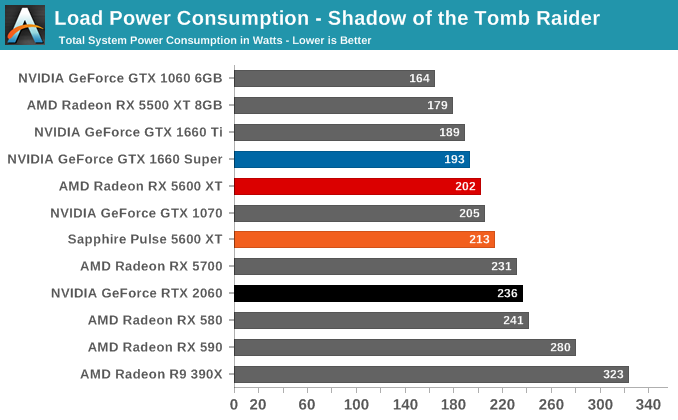
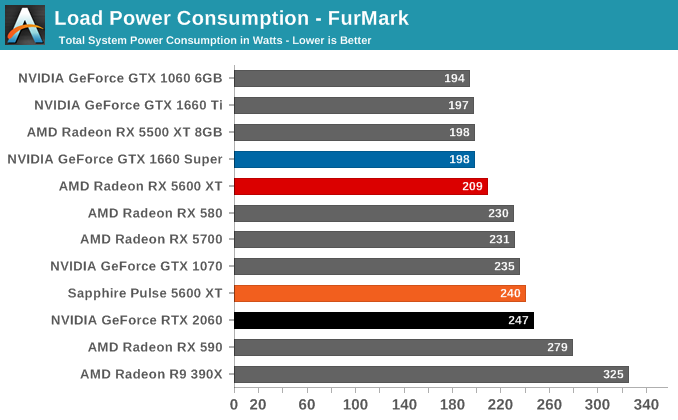
Taking a look at power consumption, we again find a good showing from Sapphire and AMD. The card’s idle power consumption shaves off a couple of watts at the wall relative to the RX 5700, thanks to the lower amount of VRAM and fully idled fans.
Meanwhile load power consumption also fares comparatively well. At reference clocks, we see AMD’s claims of higher power efficiency first-hand; measured at the wall, the card draws around 30W less than the RX 5700. Equally important, this keeps it relatively close to the GeForce GTX 1660 series. And while the RX 5600 XT ultimately ends up drawing more power, as we’ve seen it also handily outperforms those cards.
Sapphire factory overclock, however, is both a curse and a blessing. The blessing is that it improves the card’s performance to RTX 2060-levels, but the curse is that it does so while pushing power consumption to near RX 5700-levels. So when running at full tilt, the Pulse RX 5600 XT is less power efficient than the RX 5700, owing to its overall lower performance. Then again, it’s not like NVIDIA was doing very well to begin with. As a result, even when factory overclocked, the Pulse ends up drawing a bit less power than the nearest NVIDIA card.
I will also quickly note that the delta in power consumption between FurMark and Tomb Raider is higher for the RX 5600 XT than we’ve seen it in other Navi cards. All told, even at 1440p with the highest available settings, Tomb Raider is having a hard time keeping the RX 5600 XT busy enough that the card is running at maximum clockspeeds. This has made Tomb Raider turn into something of a best case scenario, as the card gets to idle a little bit.
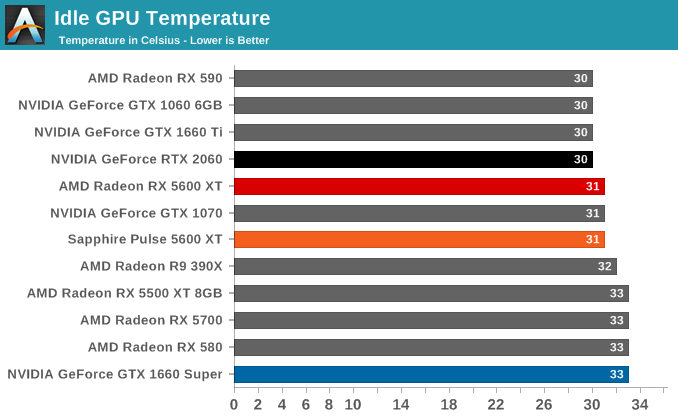
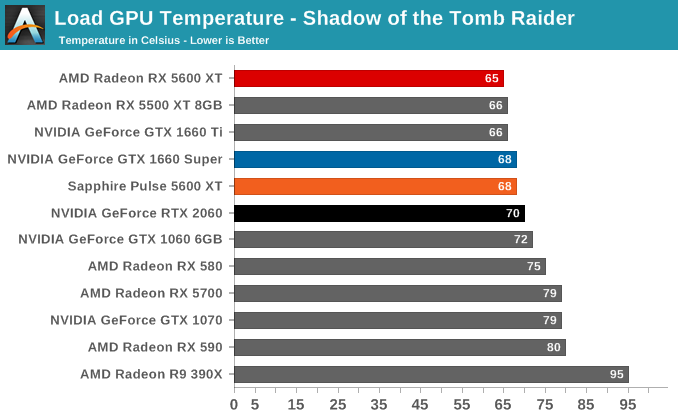

Moving on to temperatures, the large card has no problem cooling itself. In quiet mode the card never passes 68C, and even in full-on performance mode, the temperature maxes out at 74C. From a temperature perspective, Sapphire seems to have just about perfectly tuned the card’s cooler.
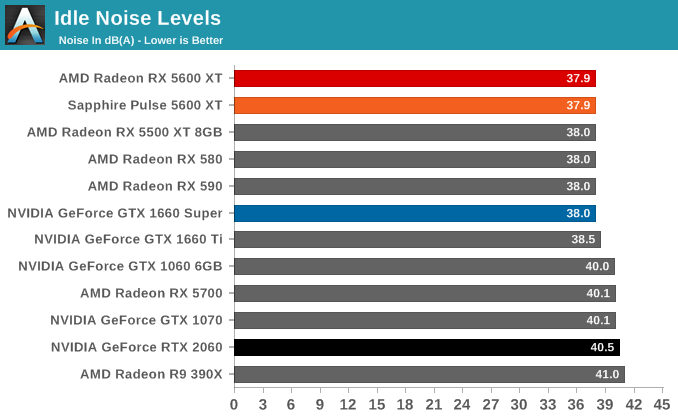
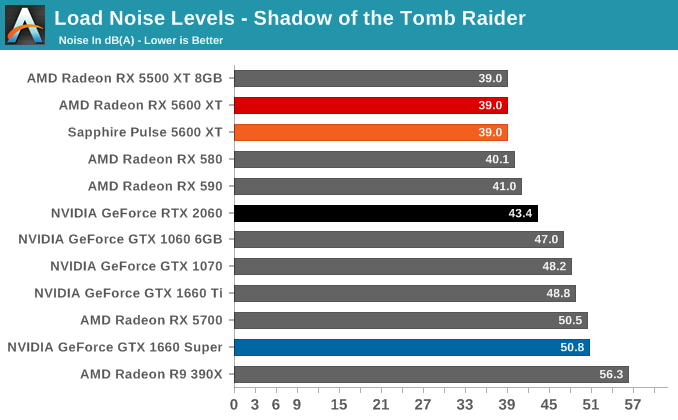

Finally, with noise, we get a chance to see how quietly the oversized Pulse can operate. And the answer is “very quietly”. At idle the card is entirely silent, thanks to its zero fan speed idle mode. Meanwhile with the quiet mode BIOS clocked at AMD’s reference clockspeeds, the fans only have to go to the card’s bare minimum fan speed – 25 percent – to keep the card cool, even under FurMark. To put this in context, we’re looking at a 150W card that’s having all of its cooling needs being met by a pair of fans running at a mere 750 RPM, which is a fraction of what they can actually run at.
Even with the factory overclock active, the cooler has no problem keeping up. Load noise for the 180W mode peaks at 41.2dB(A), which is close to silent and a great result overall. So for as much ribbing as I give Sapphire for the somewhat absurd size of the card, there’s no arguing with the effectiveness of the cooler. It’s quieter than almost every other card in this chart, including the GeForce GTX 1660 series cards and NVIDIA’s own reference RTX 2060.










202 Comments
View All Comments
maroon1 - Tuesday, January 21, 2020 - link
It does not beat RTX 2060 (after price drop) in performance per dollar while having less features. 5600XT does not sound like great value. 5500XT 8GB is even worseQasar - Tuesday, January 21, 2020 - link
but if one puts no value in those features, then what?? i dont consider RT value feature, as i wont use it, i dont play any games that use it, so why waste the money on it ( for now ) as was said in another reply, unless you get a higher end 2070 or better, the performance hit for it, makes it almost unusablesing_electric - Tuesday, January 21, 2020 - link
Especially since the 2060 is BARELY capable of RTX stuff with current-gen titles. By the time the 1st titles developed with accelerated ray tracing in mind - rather than an "add on" after a lot of the art was made and the engine was written - come out (next year?), there's a good chance the 2060 will be too slow to enable rays anyways.neblogai - Tuesday, January 21, 2020 - link
As per Hardware Unboxed review- 5600XT offers the same speed as 2060, but costs less and uses less power.maroon1 - Tuesday, January 21, 2020 - link
RTX 2060 matches 5600XT in performance per dollar without any of these features. SO even if these "extra" features are useless, 5600XT does not have any advantage anyway.I rather have RT for safety as some games in future might become RT only since next gen consoles are going RT.
DLSS runs very on wolfenstein youngblood (check digital foundary about it)
ALso, it support variable rate shading which is also supported by next gen console (at least xbox series x confirmed to use it)
Cooe - Tuesday, January 21, 2020 - link
"as some games in future might become RT only". And that's what where I realized that you have absolutely no freaking clue what in the hell you are talking about.Xyler94 - Tuesday, January 21, 2020 - link
Do you understand how computationally demanding drawing an entire scene in Ray Tracing would be?Every game today that has Ray Tracing uses it only for shadows or reflections, because anything else it would hurt performance too much. RT is amazing, and I love it... but when some of the best computer hardware takes a few days to render an image completely in RT, I don't think an RTX2060 would stand any chance at rendering an image in full RT in a second, let alone render 60 images in a second...
Remember, games needed to cut down on the amount of Rays and bounces just to get acceptable RT performance. Rendering everything in RT would require a ton of bounces to get a better image than traditional rasterization... and it's the bouncing that makes RT so computational taxing. I refer to it as bouncing, because the rays bounce off objects to create realistic shadows, lighting, and textures on objects. The more rays, and bounces you have before it goes to the "eye", the better the image is gonna look.
TL;DR: Don't hold your breath. By the time games can be fully rendered in RT, I'm guessing we'll be on the 4th or 5th generation of RT Cards from both Nvidia and AMD...
BenSkywalker - Tuesday, January 21, 2020 - link
Metro Exodus uses ray tracing for global illumination and Q2RTX uses ray tracing for GI, shadows and reflections, both playable on a 2060. I've played through those games with ray tracing on a 2060 without issue, people say Control is also, but don't have first hand experience with that(and not sure exactly what rt is used for).There are hardly any games is valid, but there are games and they are quite playable on a 2060 using ray tracing today.
Droekath - Wednesday, January 22, 2020 - link
Ray tracing on the 2060 is rather pointless, unless you want to play games at sub-30 fps on most modern titles at 1080p. If you really want to apply ray tracing, then it's advisable to get at least a 2070 or higher.maroon1 - Tuesday, January 21, 2020 - link
According to Hardware Unboxed 2060 is slightly faster. And it offer comparable performance per dollar (if 2060 is 299 dollar)